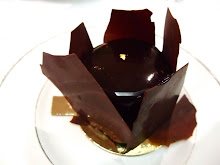
An apple a day they say, keeps the doctor away. Be it the common cold or a nebulous norovirus, everyone seems to be down with some debilitating ailment at the moment. As far as I'm concerned, winter can end now. Much as I love Nordic skiing and the winter
Olympics snow does not belong in London, and I would quite like to pack away my thermals, ear muffs and wool scarves thank you very much!
If you're finding yourself beset by recurring sniffles here are a few tips on eating your way to good health. Inspired by helpful responses I received after asking on twitter what foods help boost the immune system, I've incorporated the tweets with tips in each section, along with a few basic recipe suggestions too. Sipping endless cups of Lemsip and taking antibiotics when you need to might seem the easiest route to recovery but trust me after having been on antibiotics twice this winter I definitely recommend pre-empting future illness with healthy eating. The best strategy I've learned is eat a balanced variety of the following foods for optimal health and you'll feel - and look - better in no time :-)
1) Spices

foodieguide
@scandilicious you can boost immune system with teaspoon or 2 of good quality honey (manuka) & teaspoon of cinnamon with it, twice a day.
9:02 PM Jan 14th from Tweetie in reply to scandilicious
This was a brilliant suggestion, cinnamon and honey tea not only tastes delicious but cinnamon is a potent weapon against pretty much everything from colds to diabetes. I sprinkle it on my daily porridge and try to bake with it as much as possible.
XXorcist
@scandilicious Ginger Increases the body temperature to help fight off infections ...Gingerale contains some ginger or add ginger to food.
12:17 PM Jan 14th from web in reply to scandilicious
Ginger is another top immune boosting agent, and one I've been incorporating into my raspberry & ginger smoothie, recipe of which you can find
here
Niamh of
Eat Like A Girl also posted a gingery note today on the healing powers of Lemon, Ginger and Honey Tea
here a drink I'm trying to have every day to strike back at all dastardly bugs!
2) Vitamins (and the sun)
XXorcist
@scandilicious Get Fresh Air and some Sun every day. Eat foods with Vitamin ..( A / C / D ) every day.
12:12 PM Jan 14th from web in reply to scandilicious
Sensible advice from the somewhat fiersome sounding XXorcist. We tend to hibernate in winter, and I don't know about you but a few rays of sunshine on a cold, crisp winter's day make all the difference to my mood and outlook on life. Interestingly enough, food writer
Fiona Beckett also came across research
here that correlates vitamin D deficiency with a compromised immune system, so up your fruit, veg and dairy intake to increase the level of vitamin D in your body. And get outside as much as you can on sunny winter days!
3) Probiotics
Tamarizzo
@scandilicious Probiotics :-)
12:09 PM Jan 14th from Gravity in reply to scandilicious
LucianaBianchi
@scandilicious yoghurt(with live bacteria!!) And royal jelly!
12:06 PM Jan 14th from UberTwitter in reply to scandilicious
Kate_Q
@scandilicious Eat live yoghurt (doesn't have to say pro biotic, it's all the same). Try not to take painkillers.
11:38 AM Jan 14th from Gravity in reply to scandilicious
brockhallfarm
@scandilicious probiotic yoghurt, smoothies with real fresh fruit. I add Innocent to the smoothie mix. Get well soon!
11:36 AM Jan 14th from Tweetie in reply to scandilicious
All great tips from the probiotic crowd! We hear much about the healing powers of probiotics, but steer clear of gimmicky probiotic drinks that are packed full of sugar, and probiotic supplements in health food shops.
A Scot in London gave excellent advice on buying probiotics that have to be chilled, they are the only ones potent enough ('live' enough if you will) to survive the acidic environment of our stomachs. I picked up some at my local health food shop Alara and am amazed at how much better I felt within a week of taking them. Ask for refrigerated probiotics in your local health food shop and eat plain bio yoghurt from brands such as
Yeo Valley and
Rachel's Organic on a daily basis. Royal Jelly and bee pollen are also meant to be excellent for perking up the immune system.
4) Citrus

Citrus fruits are famously good for upping your vitamin C intake, try blood oranges which are currently in season and taste delicious drizzled with a bit of honey, a sprinkle of cinnamon and some scattered walnuts on top.
theimpishscribe
@scandilicious 'Orange' juice- satsumas, oranges, clem, mango: ginger, peach, dried apricots, oats, echinacea. 1 tsp of PB - Blend, drink xx
11:58 AM Jan 14th from web in reply to scandilicious
goodshoeday
@scandilicious vit C, zinc, echinecia (or however its spelt) and don't forget to eat some protein with all the veg and fruit & carbs pls ;)
11:43 AM Jan 14th from TweetDeck in reply to scandilicious
5) Echinacea
RosieFoodie
@scandilicious echinacea?
11:35 AM Jan 14th from Echofon in reply to scandilicious
R_McCormack
@scandilicious Echinacea
11:34 AM Jan 14th from web in reply to scandilicious
Another well-known cold and flu fighter, the easiest way to take this is in supplement form...
6) Spelt

Easy spelt bread with fennel seed, recipe
hereaforkful
@scandilicious spelt contains immune-system boosting properties
11:31 AM Jan 14th from TweetDeck in reply to scandilicious
DiscoveryDay
@scandilicious @aforkful I'm working on a spelt-ish (in fact it is the old Roman grain - Farro) risotto mix. More bite than rice, love it.
11:39 AM Jan 14th from web in reply to scandilicious
This intrigued me, being an avid spelt fan! I knew spelt was more digestible and I've been using it in bread baking for ten years now as diabetes runs in our family and spelt is better for maintaining steady blood sugar levels than plain wheat. It's also chockfull of flavour and I've taken to using refined spelt for cinnamon buns, cakes and pancakes recently. Try it, you won't be disappointed.
7) Garlic and chilli

Moroccan spiced chickpeas with spinach (photo courtesy of Andrew Crawley and the Daily Telegraph) recipe
hereThis recipe is from the
Ultimate Student Cookbook and one I
never tire of. It's quick to make, frugal and extremely tasty. You've got all the wonders of aromatic spices such as cumin, coriander, turmeric and chilli, the latter of which has brilliant antiseptic properties. Garlic is well-known for its immune boosting properties, so you could up the quantity from this recipe if you're in dire straits and if you're feeling extra brave, try crushing a clove and eating it raw. I'm not a huge fan of raw garlic, but love it with seafood such as prawns:

or just gently sauteed with some anchovies, chilli flakes and tossed with broccoli in pasta...
8) Soup
Or more accurately, chicken soup. Known as
Jewish penicillin chicken soup is the apotheosis of immune boosting soups. Nourishing and delicious in equal measure, a simple chicken soup requires little embellishment and is worth making in large batches and sipping (slurping?) throughout the day. Anthony Silverbrow's post on
chicken soup is brilliant - as a South American proverb goes "good broth resurrects the dead" and chicken soup will do exactly that!
9) Protein
This wasn't tweeted so much as just an instinctive reaction I had to feeling unwell. I craved eggs, salmon and basically anything out of the sea. Protein is needed for strength, simple as that. Try an open sandwich of soft-boiled egg, Swedish kaviar from a tube and dill on sourdough crispbread such as
Peter's Yard
For more boiled egg recipe suggestions check out Foodista:


Or indeed a few slivers of smoked salmon with black pepper on the same crispbread (you can tell I'm addicted to crispbread!):

Mackerel is not only cheap but endlessly versatile and full of essential omega fatty acids. My favourite way to eat mackerel is with either a gooseberry compote or rhubarb, such as this recipe from
Nigel Slater. Aim to eat oily fish at least two or three times a week.
10) Miscellaneous
Well, these are tips I picked up from an excellent book on nutrition
Nourishing Traditions lent to me by the good people at
Rude Health :
* Coconut oil contains lauric acid, an essential saturated fatty acid that boosts the immune system and protects against viruses, funghi and other pathogens
* Tea is full of antioxidants that help the cells in our body fight off damaging free radicals, thus keeping the cells in robust health
* Pickles such as kimchi, sauerkraut and umeboshi (Japanese pickled plums) are amazing immune enhancers. The fermentation process allows probiotic lactobacilli to develop in the pickles and these act as natural pathogen fighters. Kimchi, the Korean spicy cabbage has been linked to fighting off SARS in Korea, which you can read more about
here. Whether or not you believe kimchi will protect you from dastardly viruses, it certainly tastes good.
Finally, it goes without saying that aside from eating well a few behavioural habits really help fight off lurgies:
* Wash your hands with soap after you've been on public transport, in the shops, out and about in town. My Norwegian grandmother was a nurse and she always complained that people's hygiene changed dramatically after antibiotics and medical care improved in the second half of last century. Hand hygiene is the first line of defense in combating germs!
* Have a lymphatic drainage massage. This was suggested by
A Forkful of Spaghetti and it makes perfect sense. Our lymphatic system fights off pathogens and if it becomes congested then one of the most effective ways to reboot the lymph nodes is to massage away toxins trapped in the lymph nodes.
* Learn to say no. This might seem banal, but I learned to my cost towards the end of last year that saying yes to everything depleted my energy and enthusiasm for going out. Be selective, ruthless even, in how often you say yes to a favour, to going out or to events.
* Calm down! Adrenal fatigue is now recognised as a significant factor in the weakening of our immune systems. It seems we're all too stressed, all the time and the constant surge of adrenaline through our bodies - be it from working in stressful jobs, not sleeping enough, taking too many drugs, or in personal relationships - is seriously detrimental to our health. Relax as often as you can, try yoga, pilates or meditation. Chamomile, lemon verbena and valerian teas are all fantastic alternatives to boring old water to keep you hydrated and calm throughout the day. Hot baths, good novels, cooking a delicious meal - whatever it is that helps you unwind, do it. Ignore the maddening crowd and you'll feel so much the better for it. Exercise, curiously enough, can be calming as you vent all your frustrations through a game of footie, or on a run. My resolution is to dance more as I'm easily bored with gyms and running!
* Incidentally painkillers are also thought to
weaken the immune system, but of course use them if you're feeling rotten and can't function. See your doctor if you're feeling utterly miserable and showing symptoms beyond just a cough or temporary food poisoning. Antibiotics are essential when you're seriously ill.
What are your top tips for eating your way to good health? Feel free to comment below, and dispute any of my suggestions of course.













































































